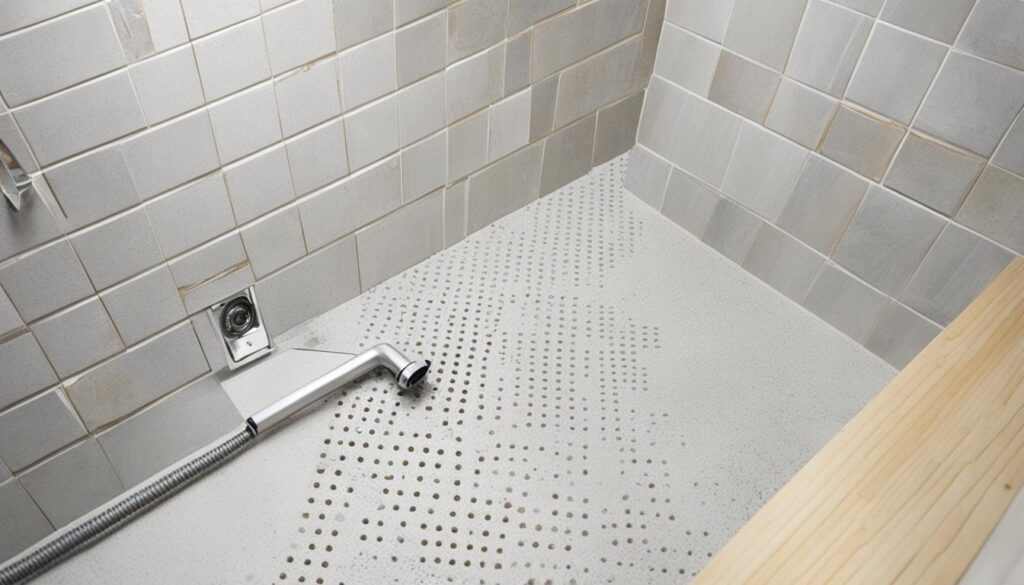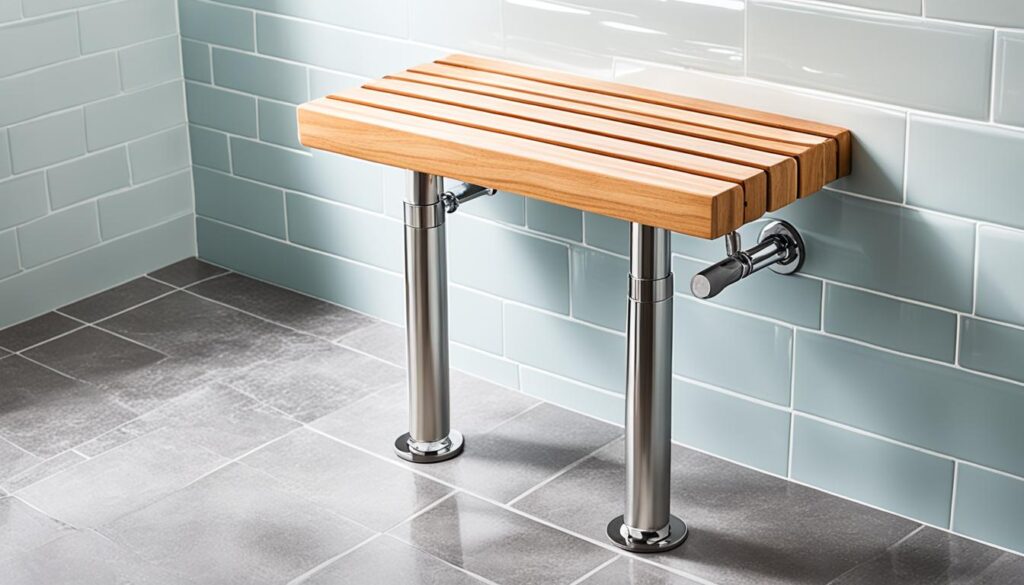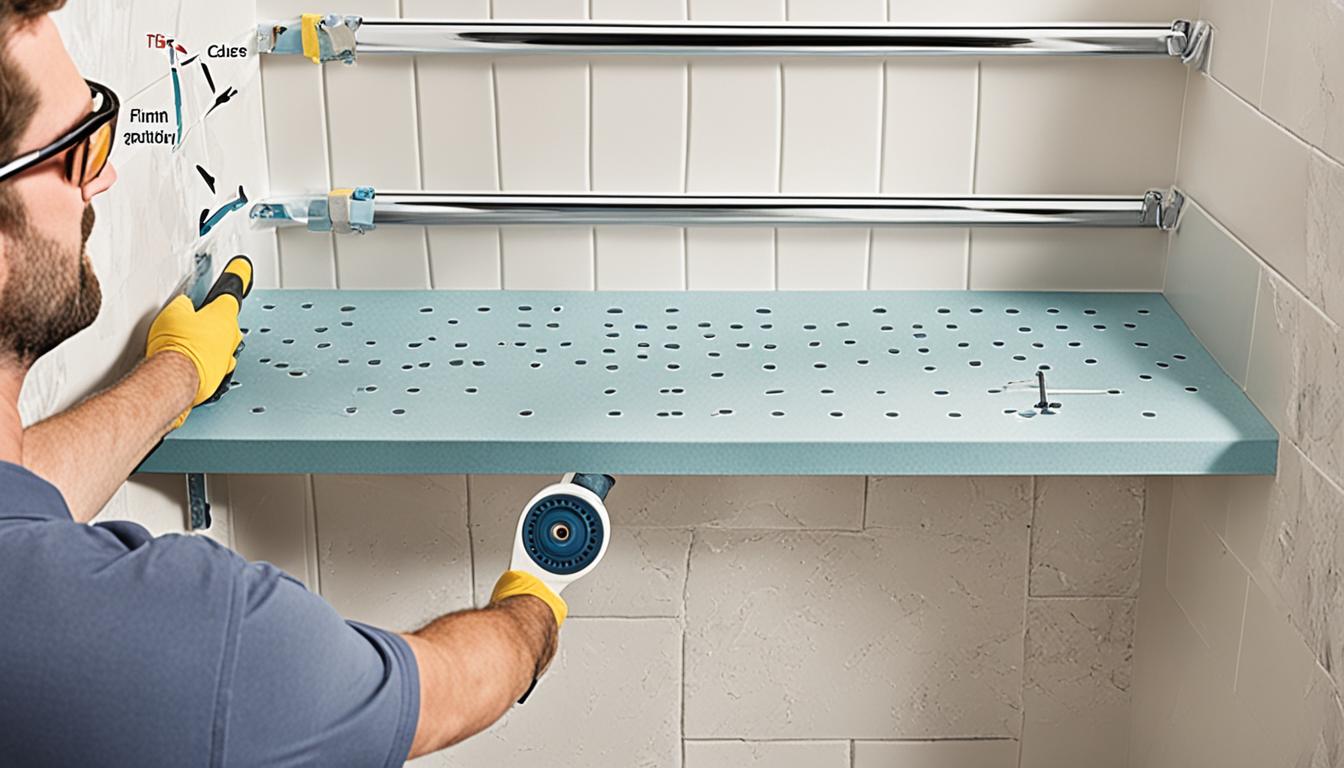Ever thought a simple change could make your bathroom better? Adding a shower bench is one such idea. It not only makes your space look good but also makes it more useful. This is especially true for people who need extra support or just want more comfort while showering.
With some basic tools and a bit of time, you can add a shower bench by yourself. This guide will show you how, from picking the right spot to making sure it drains water well, and finishing it off neatly. Are you ready to start?
Key Takeaways
- Installing a shower bench boosts bathroom functionality and comfort.
- This project can be accomplished with basic tools and materials over a weekend.
- Proper location and preparation are essential for successful shower bench mounting.
- Ensure that the bench is pitched correctly to facilitate water
drainage. - Sealing and grouting are crucial steps to prevent leaks and achieve a neat finish.
What are the Benefits of Installing a Shower Bench?
Adding a shower bench brings more than you think. It makes bathing safer and more comfortable. Let’s dive into the benefits for easier bathroom access, safety for seniors, and more.
Improved Accessibility and Safety
First off, a shower bench makes the bathroom easier to use. It’s a big help for anyone with mobility problems or disabilities. A secure place to sit lowers the chance of falling. This is key for making showers safe and easy for the elderly.
Enhanced Comfort and Convenience
A bench in the shower isn’t just comfortable. It makes things like shaving easier and lets you just relax while showering. Plus, it can hold your toiletries close by. This improves the overall bathing experience, especially for seniors.
Added Bathroom Aesthetics
But it’s not all about function. A smart-looking shower bench can also beautify your bathroom. Whether modern or traditional, it enhances the space. It fits right in with your bathroom’s style.
- Enhanced bathroom accessibility for all ages
- Improved senior bathing safety and comfort
- Stylish enhancement to bathroom aesthetics
Different Types of Shower Benches
When choosing a shower bench for your bathroom, explore all options. From built-in to stand-alone, each style has its benefits. Think about shower chair placement and non-slip shower seating.
Built-In Shower Benches
Built-in shower benches are a fixed part of your shower. They offer stable seating and look seamless. But, they must be placed correctly when designing your shower. This can mean higher costs and complex installation.
Floating Shower Benches
Floating shower benches attach to the shower wall. They make your shower look open and spacious. Easy to clean under, they add a modern touch. Still, they need careful installation for stable and non-slip shower seating.
Folding Shower Benches
Folding shower benches save space and are good for small showers. They fold up when not in use. Make sure they’re placed right so they don’t block other shower features.
Stand-Alone Shower Benches
Stand-alone shower benches are movable and flexible. They’re great for those who don’t want something fixed. Make sure they have non-slip shower seating, as they can be less stable than others.
Choosing the Ideal Location for Your Shower Bench
It’s important to pick the right spot for your shower bench for safety and ease of use. Think about how much room you have, who will use the bench, and where it can be firmly attached. If you’re modifying a bathroom to age in place, these things become even more crucial.
First, look at how much space you have in your shower. Make sure the bench won’t make the area too crowded or get in the way. For aging in place modifications, think ahead about needs like wheelchairs.
Then, look at how easy it is to reach the bench. It should be near the shower controls and things like soap. This is especially important for older users or those with movement challenges.
Finding strong wall studs for the bench is also a must. Studs help keep the bench safe and sturdy during use. Use a stud finder tool to find the best spot before installing the bench.
Also, think about the type of shower you have. In walk-in showers, the back wall is often a good place for a bench. But in roll-in showers, the bench should be where it’s easy to get to and there’s enough space to maneuver.
| Factor | Importance | Considerations |
|---|---|---|
| Available Space | High | Avoid overcrowding; accommodate future needs |
| User Accessibility | High | Proximity to controls and essentials; minimize movement |
| Wall Stud Locations | Critical | Ensure secure mounting; use stud finder |
| Shower Type | Variable | Back wall for walk-in; opposite entry for roll-in |
Make sure the bench is a comfy height for the person using it most. A height of 17 to 19 inches is usually good, but adjust for personal needs. Customizing these details makes aging in place safer and more comfortable.
Essential Tools and Materials for Shower Bench Installation
When you’re adding a shower seat, having the right tools and materials is key. This makes sure your project goes well and looks great in your bathroom. Here’s everything you need to know about what to have on hand.

Tools
To install a shower seat well, make sure you have these important tools:
- Level: It makes sure your bench is straight. This is important for safety and looks.
- Stud Finder: Finds the wall studs so your bench is securely attached.
- Saw: Cuts materials to the right size and shape.
- Tape Measure: Getting the measurements right ensures a good fit.
- Silicone Caulk: It seals the edges to stop water from getting in and makes it look finished.
Materials
Along with the necessary tools, you’ll need these materials to get a great result:
- Backer Board: Prepares the wall, giving a strong base for the bench.
- Mesh Tape: Strengthens and secures the joints.
- Wedges or Spacers: Helps the bench tilt the right way so water drains off.
- Tiles: These cover the bench surface and make your bathroom look better.
With the correct tools and materials, your new shower seat will fit right into your bathroom project. It will improve both how your bathroom works and how it looks.
Step-by-Step Guide to Shower Bench Installation
To install a shower bench correctly, you need to be precise. This will make sure it lasts a long time and works well. Here’s how to mount your shower bench the right way:
Step 1: Choosing a Location
First, pick the right spot for your bench. It should be where wall studs can support it.
Step 2: Preparing the Wall
Getting the wall ready is next. You’ll need to notch the backer board. This makes sure your bench will be stable during shower bench mounting.
Step 3: Installing the Bench
Now, set the bench in the notched space. Make sure it’s straight and secure. Getting this right is key for a good shower installation.
Step 4: Pitching the Bench
Give the bench a slight tilt forward. This lets water run off, which is key for a good shower bench mounting.
Step 5: Sealing Around the Bench
Next, use a strong waterproof caulk around the edges. This keeps water out and helps your bench last longer.
Step 6: Grouting the Tiles
Finally, put grout around the bench tiles. This finishes the look and helps seal everything in place, making your bench last.
Ensuring Shower Bench Stability and Safety
For those who are older, having a steady shower bench is key. It needs to be installed right and fixed firmly to the wall studs. This keeps it solid and stops accidents.
The right height and size of the bench make it easy to use. It’s important to adjust these for people who can’t move easily. The bench height should make sitting and standing up easy.
How much weight the bench can hold is also critical. Built-in or hanging benches might need more support to hold a person safely. Folding seats must be attached well to hold weight without failing.
Following ADA rules is a good idea, especially in public places or homes where access is important. These rules give clear sizes and safety tips that help keep older adults safe while bathing.

- Secure attachment: Ensure the bench is firmly attached to wall studs.
- Proper height and depth: Adjust these dimensions for maximum comfort and ease of use.
- Weight support: Reinforce in-built or floating benches and secure folding seats.
- Compliance with ADA: Follow these guidelines for enhanced accessibility and safety.
Waterproofing Your Shower Bench
Keeping your shower bench in good shape starts with waterproofing. There are a few ways to make sure it stays dry.
Types of Waterproofing Methods
For shower benches, you can use topical membranes or traditional techniques. Each method works well, depending on what you need.
Waterproofing with Topical Membranes
Topical membranes go right onto your bench’s surface. They stop moisture right away. Products like liquid membranes and Kerdi sheets are great for this. They’re easy to use and protect well.
Traditional Waterproofing Techniques
With traditional methods, you put a membrane under the surface. This way covers more area but takes care to get right. Properly done, it guides water to the drain efficiently.
Cost Considerations for Shower Bench Installation
Understanding the costs involved in shower bench installation is crucial for your budget. The price changes based on the bench type, size, and materials. Whether you do it yourself or get a pro also affects the cost. Benches like built-in or wall-mounted ones can change the overall expense.
Comparison of Various Types of Benches
Shower bench prices vary by type and material. Built-in benches cost between $300 and $800, offering durability. Wall-mounted benches, saving space, may reach $1,000. ADA-compliant benches, with special features for accessibility, might cost more. Think about your needs and bathroom size when choosing.
DIY vs. Professional Installation Costs
Choosing between DIY and professional installation affects cost. Doing it yourself saves on labor but requires skills and tools for safe installation. Professional installation costs more but ensures stability and safety. It’s important for ADA-compliant benches, where pros meet accessibility standards and fit the bench perfectly with your bathroom.
FAQ
What are the most important reasons to install a shower bench?
What options do I have for shower benches?
What should I think about when placing a shower bench?
What do I need to install a shower bench?
Should I install a shower bench by myself or hire someone?
How can I make sure my shower bench is stable?
What’s involved in waterproofing a shower bench?
What’s the typical cost of installing a shower bench?
FAQ
What are the most important reasons to install a shower bench?
A shower bench increases safety, especially for older people and those with mobility challenges. It adds comfort and helps with tasks like shaving. It can also offer extra storage and improve the look of your bathroom.
What options do I have for shower benches?
There are several types of shower benches. These include built-in, floating, folding, and stand-alone benches. Each type offers different benefits for your bathroom’s design and functionality.
What should I think about when placing a shower bench?
Think about how much room you have, how easy it will be to reach, and where the wall studs are. It’s also important to consider the type of shower to make sure it’s safe and works well.
What do I need to install a shower bench?
You’ll need a few tools like a level, stud finder, saw, and tape. For materials, get backer board, mesh tape, and tiles. Using these correctly will help make sure your installation goes smoothly.
Should I install a shower bench by myself or hire someone?
You can try to install a bench yourself with some basic tools. However, for the best safety and to meet standards, you might want to hire a professional. This is especially true for more complicated benches.
How can I make sure my shower bench is stable?
Make sure to attach the bench securely to wall studs. The height and depth should be comfortable, and it must hold up the user’s weight. Some benches, like floating ones, may need extra support.
What’s involved in waterproofing a shower bench?
To waterproof, use special membranes on top of the bench’s base or behind it. Doing this right is key to stopping water damage.
What’s the typical cost of installing a shower bench?
The price depends on the kind of bench, its size, and materials. Built-in benches are between 0 and 0. Fold-down wall benches might cost up to
FAQ
What are the most important reasons to install a shower bench?
A shower bench increases safety, especially for older people and those with mobility challenges. It adds comfort and helps with tasks like shaving. It can also offer extra storage and improve the look of your bathroom.
What options do I have for shower benches?
There are several types of shower benches. These include built-in, floating, folding, and stand-alone benches. Each type offers different benefits for your bathroom’s design and functionality.
What should I think about when placing a shower bench?
Think about how much room you have, how easy it will be to reach, and where the wall studs are. It’s also important to consider the type of shower to make sure it’s safe and works well.
What do I need to install a shower bench?
You’ll need a few tools like a level, stud finder, saw, and tape. For materials, get backer board, mesh tape, and tiles. Using these correctly will help make sure your installation goes smoothly.
Should I install a shower bench by myself or hire someone?
You can try to install a bench yourself with some basic tools. However, for the best safety and to meet standards, you might want to hire a professional. This is especially true for more complicated benches.
How can I make sure my shower bench is stable?
Make sure to attach the bench securely to wall studs. The height and depth should be comfortable, and it must hold up the user’s weight. Some benches, like floating ones, may need extra support.
What’s involved in waterproofing a shower bench?
To waterproof, use special membranes on top of the bench’s base or behind it. Doing this right is key to stopping water damage.
What’s the typical cost of installing a shower bench?
The price depends on the kind of bench, its size, and materials. Built-in benches are between $300 and $800. Fold-down wall benches might cost up to $1,000. Doing it yourself saves money but having a pro can add value.
,000. Doing it yourself saves money but having a pro can add value.






